Header logo
header top contact widget
Periodontitis
Arthritis? Recommit Yourself To Having Good Oral Health.
Posted on Jun 20, 2021 by William J. Claiborne, DDS MS
According to the Centers For Disease Control & Prevention (CDC), over 47 percent of American adults are living with some level of gum disease. For those age 65 and older, this figure jumps to 70 percent.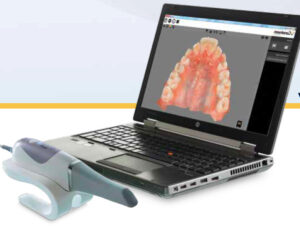
These concerning statistics are nothing to ignore. Although gum disease is so common, it increases risks that go far beyond the mouth. Over the years, research has tracked many diseases and conditions that correlate with gum disease bacteria. The inflammatory reactions triggered by these infectious bacteria have been linked to heart disease, stroke, some cancers, diabetes, preterm babies, and impotency.
Research has also shown a notably close relationship between gum disease and rheumatoid arthritis (RA). These studies have been ongoing for many years, and the findings should be concerning to all adults.
RA is a debilitating, painful disease that destroys joints. RA often emerges gradually, initially causing morning stiffness and weak, sore muscles. As inflammation from RA worsens, joints become swollen. Joints become achy and stiff most often in the fingers, wrists, elbows, hips, knees, ankles, toes and neck. Unfortunately, there is no cure for RA.
On a positive note, studies have shown that treating RA patients who have periodontal disease helps to improve RA symptoms. It is felt that this occurs because of a lighter burden of oral inflammation to the body’s immune system.
Below are some of the findings you may want to review. First, however, it’s important to understand how gum disease begins and some signs and symptoms.
In the initial stage of periodontal (gum) disease, known as gingivitis, the gums may bleed when brushing. Bad breath is more frequent and the gums may be tender or swollen. As the disease progresses, the gums turn red and may pull away from the base of some teeth.
Bad breath becomes persistent and pus pockets may form at the base of some teeth. As the infectious bacteria attack the bone structures that support tooth roots, teeth will begin to loosen and may need removal. Gum disease is the leading cause of adult tooth loss in the U.S.
In addition to the devastating damage in the mouth, the infectious bacteria of gum disease can enter the bloodstream through diseased gum tissues, causing the inflammatory triggers that activate serious health problems, such as RA.
Years ago, researchers noticed an RA-perio trait among people with rheumatoid arthritis. While RA sufferers had gum disease more often, they observed that people with gum disease tended to have RA more often.
As researchers delved deeper into the connection, it appeared that the association is much more complicated than previously thought. Findings now suggest that oral bacteria could actually be a cause of rheumatoid arthritis.
In the past, doctors felt that periodontal disease was a result of RA itself since stiff, painful hands make it challenging to maintain good oral hygiene. They also suspected that medications prescribed to treat RA could be a factor since the drugs, which suppress the immune system, inhibited the body’s ability to fight harmful oral bacteria.
Both conditions cause chronic inflammation in tissues that connect to bone with both diseases having a similar inflammatory trigger. Even more similar is the particular species of bacteria found in periodontally-diseased tissues when compared with tissues around arthritic joints. In one study, a particular pathogen associated with periodontal disease was found to activate the same destructive process of rheumatoid arthritis.
In 2017, study findings were released by Johns Hopkins University Division of Rheumatology, which noted evidence that the tissues in the mouth of a periodontally-compromised individual and the tissues of the joint in RA have a number of likenesses. Research has also shown a genetic link between the two.
Above all, these findings reinforce how oral health correlates closely to our overall health. When you consider how the presence of gum disease can significantly increase your risk for serious health conditions, having good oral health should be a priority for every American.
What can you do to lower your risks for tooth loss and contributing to (or worsening) serious health problems? Recommit yourself to thorough oral hygiene at home and having twice-a-year exams and cleanings.
If you have signs of gum disease, have treatment at your earliest convenience. Gum disease will only worsen and requires more treatment time and expense as it progresses.
Call 828-274-9440 to schedule an examination, or begin with a consultation to discuss your needs.
https://www.hopkinsrheumatology.org/2017/01/gum-disease-linked-to-rheumatoid-arthritis/
https://www.cdc.gov/oralhealth/conditions/periodontal-disease.html
https://pubmed.ncbi.nlm.nih.gov/17551378/
Oral Bacteria Can Put An Immune System At A Disadvantage
Posted on May 20, 2021 by William J. Claiborne, DDS MS
Long before the COVID pandemic, it was widely known in the medical/dental and scientific communities that the bacteria in the mouth was intricately connected to the body’s overall health.
The oral cavity (interior of the mouth) contains some of the most varied and vast flora in the human body. It is the entryway for two systems vital to human function and physiology, the gastrointestinal and respiratory systems. Therefore, specific infections in the oral cavity may contribute to infection that can affect systemic health.
Systemic health refers to issues that affect the entire body, rather than a single organ or body part. An example of a systemic disorder is high blood pressure, which affects the body as a whole.
Research demonstrates that inflammation is a likely trigger for the systemic connection. For this reason, researchers have studied inflammation in the oral tissues caused by periodontal (gum) disease as a contributing factor of continual inflammation in the body.
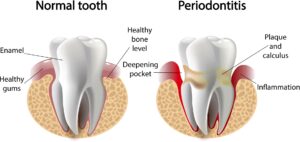 Hundreds of diseases and medications impact the oral cavity. Although the precise point of activation remains to be determined with some health problems, there is a more obvious association between oral bacteria and certain conditions.
Hundreds of diseases and medications impact the oral cavity. Although the precise point of activation remains to be determined with some health problems, there is a more obvious association between oral bacteria and certain conditions.
For instance, diabetes has a clear relationship with periodontal disease. Strong evidence shows that treating one condition positively impacts the other. By the same token, uncontrolled inflammation levels of one can worsen inflammation levels in the other.
Therefore, treating inflammation may not only help manage periodontal diseases but may also help manage other chronic inflammatory conditions.
Oral bacteria has been found to trigger or worsen other systemic conditions, including atherosclerotic vascular (heart) disease, pulmonary (respiratory) disease, diabetes, pregnancy-related complications, osteoporosis (bone loss), and kidney disease. A shared trait between gum disease and these medical conditions is that they are chronic conditions that take a long time to develop.
https://www.agd.org/docs/default-source/self-instruction-(gendent)/gendent_nd17_aafp_kane.pdf
According to the Centers of Disease Control & Prevention (CDC), nearly half of American adults ages 30 and over have gum disease – a whopping 47 percent. In a recent study, they found that about 9 percent have mild levels of gum disease, 30 percent have moderate levels and 8.5 percent have severe gum disease (periodontitis).
Researchers of a recent study found that 64 percent of adults ages 65 and older had either moderate or severe periodontitis. Gum disease rates were highest in males, Mexican Americans, adults with less than a high school education, adults below the poverty line and current smokers.
Although the initial stages of gum disease may be concealed behind the lips and cheeks, the interior of the mouth can signal the presence of periodontal disease at nearly every stage. For example, sore and swollen areas can indicate gingivitis, an early form of gum disease.
Worsening levels of gum disease can cause redness, tenderness, bad breath, bleeding when brushing, and receding gums. Progressive gum disease can lead to persistent bad breath, pus pockets forming around teeth, loosening teeth and painful chewing.
In your regular dental check-ups, your dental hygienist uses a “probe” to measure “pockets” along the base of teeth. During the exam, he or she measures the gum depth along each tooth – front, back and in-between. These depth measurements indicate areas where gum tissues have loosened from the base of teeth, and to what extent. The higher the number, the deeper the pocket.
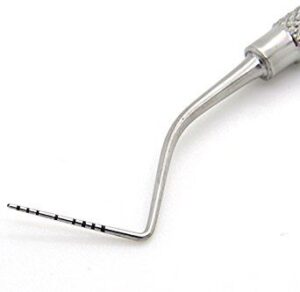 For example, healthy gums will measure 1 or 2. In some areas that are harder to reach when brushing or flossing, a 3 may be measured. However, a 4 or higher number indicates the gums are loosening their protective grip from the tooth. This leaves the tooth at risk for bacterial penetration below the gums.
For example, healthy gums will measure 1 or 2. In some areas that are harder to reach when brushing or flossing, a 3 may be measured. However, a 4 or higher number indicates the gums are loosening their protective grip from the tooth. This leaves the tooth at risk for bacterial penetration below the gums.
Healthy gums wrap snugly around the base of each tooth. This prevents the entry of bacteria, which can cause damage to the tissues and bone structures supporting tooth roots. Gum disease, to no surprise, is the nation’s leading cause of adult tooth loss.
However, infectious bacteria of gum disease don’t necessarily remain confined to the mouth. Through tears in diseased gum tissues, the bacteria are able to enter the bloodstream. Traveling through the body, these potent organisms can trigger reactions that activate or worsen serious health conditions.
For example, studies have indicated a relationship between periodontal disease and stroke. In one study focused on oral infection as a risk factor for stroke, people diagnosed with acute cerebrovascular ischemia showed a higher likelihood for having an oral infection than those who had healthy gums. (https://www.perio.org/consumer/gum-disease-and-heart-disease)
Along similar lines, men with gum disease have been found to be 49 percent more likely to develop kidney cancer, 54 percent more likely to develop pancreatic cancer, and 30 percent more likely to develop blood cancers.
Having healthy gums is actually easy – and rather inexpensive. Adults should brush thoroughly (at least 2 minutes) twice a day and floss daily. Snacking and sugar should be limited. The mouth should be kept moist throughout the day by drinking plenty of water (coffee, colas and tea doesn’t count). Moisture can also be replenished by the use of specially formulated oral rinses (available over-the-counter at many drug stores). By all means, drink alcohol moderately and avoid smoking.
Additionally, adults should maintain their 6-month dental check-ups and cleanings. These appointments help to remove any build-up of plaque or tartar on teeth so they are easier to maintain between visits. Too, your hygienist can point out areas of risk so you can concentrate appropriately during your at-home oral hygiene regimen.
If you’ve delayed (or avoided) regular dental care, your likelihood of having some level of gum disease is pretty high, even though you may not have obvious symptoms in early stages. Gum disease, once underway, does not go away on its own. It will gradually worsen and become a source of infectious bacteria that strains your immune system and increases your risks for serious health problems.
Begin with an examination appointment by calling our beautiful Asheville periodontal dental office at 828-274-9440. Here, we treat our patients with compassion, respect and with comfort a priority at all times. And, we provide patients with decades of experience and advanced skills — along with exceptional dental technology – so your treatment is successful and performed efficiently and effectively in minimal time.
While your smile is greatly important to your appearance, it’s what you can’t see that may harbor a rather ugly presence. Let’s get your smile in great shape!
Your Tongue Is A Multi-Tasker!
Posted on May 05, 2021 by William J. Claiborne, DDS MS
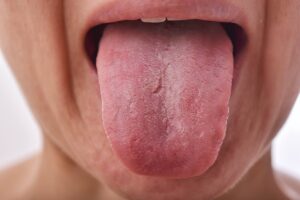 With the tongue occupying such a large area inside the mouth (or ‘oral cavity’), you’d think its anatomy would be common knowledge. Because this muscle functions continually without tiring, it tends to be taken for granted. It’s importance to your overall health, however, is unbounded.
With the tongue occupying such a large area inside the mouth (or ‘oral cavity’), you’d think its anatomy would be common knowledge. Because this muscle functions continually without tiring, it tends to be taken for granted. It’s importance to your overall health, however, is unbounded.
To correct a common misconception about the tongue, it is not the strongest muscle in the body. Although it ranks in the top 5 or so, the muscles surrounding the eyes actually have that supremacy. The heart, deemed the hardest working muscle in the body, and the masseter (jaw muscle) are also among those that are the body’s stand-outs.
The tongue does many things. It provides our sense of taste, is vital in pronunciation, moves food around as we chew, and aids in swallowing while helping to prevent certain things from being swallowed.
Not one muscle but a combination of 8, the tongue is coated with papillae. These are the tiny, bumpy protrusions on its surface. They help in various ways but are mostly credited for our sense of taste.
Different areas of the tongue are more sensitive to certain tastes. For example, the tip of the tongue detects sweet to the greatest extent while the sides detect sour. 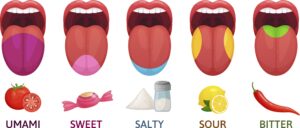
Papillae also sense touch so that we can feel the form and texture of food.
Saliva helps to keep the tongue moist so it can move around the oral cavity freely. Saliva is also helpful to the tongue by moving bacteria from its surface. However, saliva cannot keep the tongue bacteria-free.
Saliva and food residue can get stuck in the grooves between the papillae, especially on the last third of the tongue. This can create areas for bacterial growth. These bacteria thrive on remains of protein-rich food like fish, cheese or milk.
Here is where, as an Asheville periodontist, I have a particular interest in the tongue. As bacteria accumulate, a whitish film covers the tongue, which also causes bad breath. Keeping bacteria in the mouth to manageable levels is greatly supported by saliva flow.
The tongue’s underside covers two salivary glands of the lower jaw (submandibular glands). These ducts are located where the tongue meets the floor of the mouth.
If you’ve read some of my previous articles, you’ll recall that I’m constantly reminding readers of the hazards of having a dry mouth. Smoking, consumption of alcohol and caffeine, and many medications are all obstacles to the salivary glands being able to function efficiently.
A dry mouth provides a breeding ground for bacteria reproduction. When you consider the amount of bacteria embedded in the tongue’s surface, oral bacteria levels in the mouth can run rampant.
Because the tongue’s surface color can indicate too much oral bacteria, it should be looked at during at-home oral hygiene regimens. It is advised that, after brushing teeth, using the toothbrush to brush the tongue. This can dislodge an enormous amount of bacteria.
Although brushing the tongue tends to be done on the front area, it’s helpful to brush towards the back of the tongue where most bacteria exist (hence, the whiter color and smoother surface). Gagging will stop you from going too far so use that as a guide.
Some toothbrushes have a tongue scraper surface on the back side of the bristles. There are also tongue scrapers available for purchase. These are flexible strips that should be used to scrape from back to front 3 or more times after brushing. Rinsing the scraper is advised after each pass.
To provide even more support in helping the oral cavity control bacteria, an oral rinse can be very helpful. After brushing (for a minimum of 2 minutes) and flossing, swish for 30 or more seconds with an alcohol-free mouthwash. While the intensity of the mouthwash may be greater with initial use, most people notice its easier to swish around the mouth within a week or so.
Low bacteria levels in the mouth make for fresh breath and reduced risk of developing cavities and gum disease. Periodontal disease begins with gingivitis, which causes gum tissues to be tender and bleed when brushing.
Periodontitis, an advanced stage of gum disease, causes red, sore, spongy gums. Other symptoms are persistent bad breath, bleeding easily, gums that loosen from the base of teeth, and teeth that loosen.
Periodontitis can also cause health risks far beyond the mouth. Because these infectious bacteria can enter the bloodstream through tears in the gum tissues, it has been shown to trigger or worsen the development of serious health problems. Some of these are stroke, heart disease, arthritis, Alzheimer’s disease, some cancers, and diabetes.
When it comes to the tongue, remember its important role to your oral and overall health. Keep the mouth moist and its surface clean and your reward will be sweet (without the calories!).
If you are experiencing any signs of gum disease, call 828-274-9440 for an appointment. Gum disease does not go away on its own and will progressive worsen without treatment. Remember – it is the number one cause of adult tooth loss in the U.S.
Advanced Skills & Technology Enhance Comfort, Speed Healing
Posted on Apr 27, 2021 by William J. Claiborne, DDS MS
If you’ve ever watched a cabinet maker, his skill and attention to detail is impressive. He knows the various wood types, understands the details of joints and angles, and respects the individual components as interacting pieces that will work harmoniously as a whole.
Because he has the tools and skills specific to his craft, the coming-together of this typically provides a ‘forever’ result.
In the periodontal specialty, our specific skills create a number of advantages for patients who have different needs. Some of these skills are not always obvious, yet they allow for a higher level of success, greater comfort, and less time required for healing.
A periodontist, as defined by the American Academy of Periodontology (perio.org), is:
“A periodontist is a dentist who specializes in the prevention, diagnosis, and treatment of periodontal disease, and in the placement of dental implants. Periodontists are also experts in the treatment of oral inflammation. Periodontists receive extensive training in these areas, including three additional years of education beyond dental school. They are familiar with the latest techniques for diagnosing and treating periodontal disease, and are also trained in performing cosmetic periodontal procedures.”
As an Asheville periodontal specialist for over 25 years, I’ve utilized my advanced skills to help patients with a variety of needs that involve the gum tissues. These include:
– Treatment of all stages of gum disease (gingivitis, pregnancy gingivitis, periodontal disease, periodontitis)
– Reshaping gum tissues for esthetic enhancement (crown lengthening, gingivectomy for ‘gummy smiles’, repairing areas of gum recession)
– Diagnosis and placement of dental implants
– Treatment of lesions or cysts in oral tissues
Although there are other treatments offered, our main goal is to provide the patient with a comfortable and positive experience within our specialized skills. We believe that patients will come to appreciate the advantages of having a healthy smile and understand how our involvement can create a healthier, more confident individual.
Here, our Western North Carolina periodontal dental office features some of the most advanced technology in dentistry. Many of these are not available in other dental offices elsewhere. Some of these features include: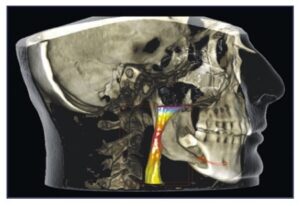
LANAP With PerioLase MVP 7 – Laser-Assisted New Attachment Procedure is an advanced protocol that efficiently and effectively treats advanced gum disease with the added advantages of a dental laser. This offers a non-surgical alternative for patients with moderate to severe periodontal disease. LANAP treatment leaves very little discomfort and has a quick recovery time. It has also been found to stimulate bone regrowth in damaged areas.
3-D Cone Beam Imaging – Ideal for diagnoses and treatment planning, these images provide a clear view of the upper and lower jaw, used for: intricate review of endodontics; periodontics; orthodontics; implantology: TMJ; and prosthodontics, as well as dental and maxillofacial surgery. Because cone beam radiographs show sagittal, axial, and coronal planes, locating and tracking nerve canals optimizes implant placement. The process is quick, painless and at minimal levels of radiation.
CareStream Cone Beam Computer Tomography Imaging – This enhanced tomography works with 3D imaging for exceptional detail and range.
CS 3600 Intraoral Scanner – Rather than make impressions with bulky, goopy trays, this scanner quickly and comfortably captures digital impressions accurately and easily for creating precision models or appliances (crowns, inlays, onlays, bridges, orthodontic appliances and aligners, custom abutments). The scanner can also reach difficult–to–access areas in the patient’s mouth for superior results with improved patient comfort.
Computerized Dental Implant Placement – This advanced system for pre-surgical positioning of dental implants uses a 3D model of the patient’s jaw. Once the implant type is selected, a template is developed for optimal treatment success, even for complex cases.
In addition, we offer a unique environment for comfort. We understand how dental fear or anxiety can cause people to delay or avoid having dental treatment, sometimes for decades. Too, when regular dental cleanings and check-ups are not maintained, the results often culminate into more complex problems (and necessary repairs) in the future.
We help patients understand that these fears and concerns are not unusual. Our doctors and staff respect each patient and provide gentle, compassionate care – at every appointment.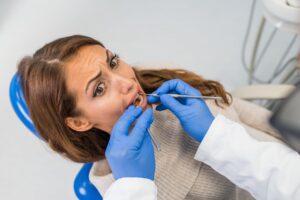
For those who have high fear levels, we offer several sedation options, including oral and IV sedation. Oral sedation is a pill that helps patients relax. It also has an amnesiac effect, leaving most with little or no memory of treatment afterward.
I.V. sedation (also known as ‘twilight sleep’) places the patient in a deeper sleep state and erases memory of the procedure. It is administered by a doctor of anesthesiology for optimal comfort and safety. In our Asheville office, anesthesia is overseen by a Medical Doctor (MD) who is a board certified Anesthesiologist.
With both sedation options, patients are closely monitored with advanced safety equipment throughout treatment.
How I would describe the difference between a periodontist and other dental specialists is in how gentle and respectful we are to the tissues in the mouth. These are tender layers that significantly affect the appearance of a smile and the health of teeth. By understanding the techniques to minimize incisions while effectively treating each area in the mouth, a periodontist is your expert.
We feel you’ll find no better periodontal dental environment. Call 828-274-9440 to learn more or to schedule a consultation appointment. New patients are always welcome and a referral is not required.
Recent Posts
Categories
Archives
- September 2024
- August 2024
- July 2024
- June 2024
- May 2024
- April 2024
- March 2024
- February 2024
- January 2024
- December 2023
- November 2023
- October 2023
- September 2023
- August 2023
- July 2023
- June 2023
- May 2023
- April 2023
- March 2023
- February 2023
- January 2023
- December 2022
- November 2022
- October 2022
- September 2022
- August 2022
- July 2022
- June 2022
- May 2022
- April 2022
- March 2022
- February 2022
- January 2022
- December 2021
- November 2021
- October 2021
- September 2021
- August 2021
- July 2021
- June 2021
- May 2021
- April 2021
- March 2021
- February 2021
- January 2021
- December 2020
- November 2020
- October 2020
- September 2020
- August 2020
- July 2020
- June 2020
- May 2020
- April 2020
- March 2020
- February 2020
- January 2020
- December 2019
- November 2019
- October 2019
- September 2019
- August 2019
- July 2019
- June 2019
- May 2019
- April 2019
- March 2019
- February 2019
- January 2019
- December 2018
- November 2018
- October 2018
- September 2018
- August 2018
- July 2018
- June 2018
- May 2018
- April 2018
- March 2018
- February 2018
- January 2018
- December 2017
- November 2017
- October 2017
- September 2017
- August 2017
- July 2017
- June 2017
- May 2017
- April 2017
- March 2017
- February 2017
- January 2017
- December 2016
- November 2016
- October 2016
- September 2016
- August 2016
- July 2016
- June 2016
- May 2016
- April 2016
- March 2016
- February 2016
- January 2016
- December 2015
- November 2015
- October 2015
- September 2015
- August 2015
- July 2015
- June 2015
- May 2015
- April 2015
- March 2015
- February 2015
- January 2015
- December 2014
- November 2014
- October 2014
- September 2014
- August 2014
- July 2014
- June 2014
- May 2014
- April 2014
- March 2014
- February 2014
- January 2014
- December 2013
- November 2013
- October 2013
- September 2013
- August 2013
- July 2013
- June 2013
- May 2013
- April 2013
- March 2013
- February 2013
- January 2013
- December 2012
- November 2012
- October 2012
- September 2012
- August 2012
- July 2012
- June 2012


